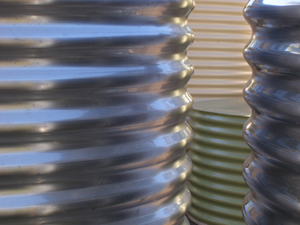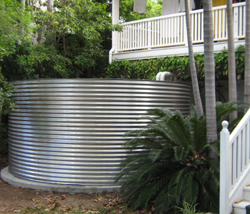 Why Steel Water Tanks?
Why Steel Water Tanks?
When looking for water tanks there are many options available to you. Steel and polyethylene are the most common materials for water tanks found in Australia. Other materials include fibreglass, concrete and PVC bladder tanks.
Each material type has its strengths and weaknesses, but at Gardeners Watertanks Australia we believe the modern steel tank has the best features of all water tanks currently available.
Steel tanks do not bulge or stretch when full. The strength of steel means the tanks comfortably hold the large forces generated by tonnes of water. Steel tanks have been around for more than 100 years so the structural long life is a proven fact. Gardeners Watertanks Australia has engineer certification on our range of water tanks. In addition this strength will not deteriorate over time under the harsh Australian sun, as it may with other materials.
In the early days steel tanks were just plain galvanised steel, with no additional corrosion protection. This is a thing of the past with modern steel tanks, which are made from Bluescope steel AQUAPLATE® and have a long life polymer coating. This polymer coating is on the inside of the tank walls and on both sides of the base (inside and out). The water never touches the steel directly, and our tanks carry a 20 year warranty against corrosion. The strength of steel, combined with the longevity of a polymer coating gives you the best of both worlds.
The traditional steel water tank not only looks iconic, but it is less bulky than other alternatives. This is especially noticeable in the slimline format where polyethylene tanks are typically much larger for the same capacity of water. The same applies for the round water tank where the flatter roof structure of a steel tank means more water right to the top of the tank, compared to the unused air gap in domed roofed plastic tanks.
The steel used in Gardeners water tanks is made here in Australia. Steel is a very long lasting material, especially when coated with zinc galvanising or Bluescope steel Colorbond® finish. It is also important to recognise that if your tank is no longer required at any time, that the material is completely recyclable, and may be readily reclaimed and reused. This makes a steel water tank the best environmental alternative.
An independent study, conducted by the Centre for Sustainable Technology at the University of Newcastle, presents a comparison based on Life Cycle Analysis (LCA) of the three types of rain water tanks. The LCA includes all stages in the life of the water tank: extraction and processing of raw materials, transport to tank manufacturing site, water tank fabrication, transport to customer’s site, installation, operation and disposal at the end of the useful life.
 Based on this LCA study the following conclusions could be made:
Based on this LCA study the following conclusions could be made:
• Rain water tanks made from AQUAPLATE® steel have the lowest overall environmental impact.
• Compared to concrete and HDPE rain water tanks, AQUAPLATE® steel has the lowest embodied energy, GGE and SOx emissions.
• Water tanks made from both AQUAPLATE® steel and HDPE performed similarly in terms of water and NOx environmental burdens, outperforming concrete tanks.
• Compared to a tank made from AQUAPLATE® steel, there is 50% more steel in a concrete tank as part of the structural reinforcement.
• The annual environmental burden of a water tank made from AQUAPLATE® steel is equivalent to one 100W light bulb switched on for approximately one week.
